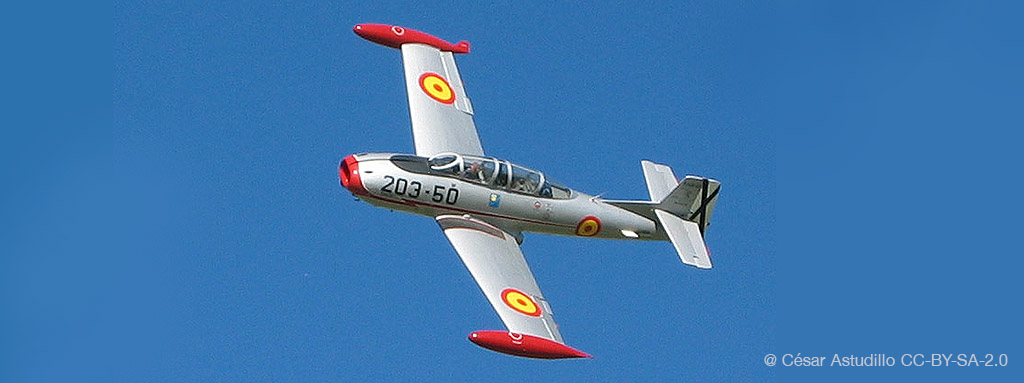I have nostalgic memories from when I was a child of sitting next to my father on cold nights, beside the wood stove we had at home. I loved to hear him tell anecdotes about his time in the military service in the Tablada barracks, in Seville, when it still had an operational runway for fighter aircraft.
The manufacture of the Saeta is one of the best examples of the aeronautical tradition in Spain.
One of those times, while I listened to him with all the pleasure of a son who sees his father as a true hero, he recounted the exploits of a commander at the controls of a HA-200. He used to talk about that plane all the time:
“The Saeta (HA-200) and the Super Saeta (HA-220) were among the best aircraft Spain has ever had. Their design, manoeuvrability and speed were truly special. The commander would often decide to carry out test flights of the Super Saeta, and would begin to accelerate and perform quick turns. Sometimes we would see him take the line of the Guadalquivir River and almost touch the water, raising a wake behind him. When he was near the iron bridge connecting San Juan de Aznalfarache with Seville, he would accelerate the engines and pass through one of the arches of the bridge.”
The iron bridge (which is how it is known) is no more than ten metres high over the surface of the river, and the distance between the arches of the bridge is about sixty metres. Logically, for an aircraft that is 3.2 metres high and has a wingspan of 10.4 metres, the bridge’s arches were ample enough in size. But what about the speed? The commander would make his passes at around 500 km/h, and at that speed everything becomes small.
My father’s stories made me admire the Super Saeta, and that’s where my interest in its history came from.
The HA-200 and the subsequent HA-220 aircraft were manufactured by Hispano Aviación Sociedad Anónima (HASA). It was designed by a group of engineers including Rafael Rubio Elola (promoter of canard systems on the front of supersonic aircraft for longitudinal equilibrium), under the supervision of Wilhelm Emil Messerschmitt (creator of the Me 262 jet fighter, used in World War II). It was the first jet aircraft designed and manufactured in Spain. On 12 August 1955, the test pilot Fernando de Juan Valiente carried out its first flight.
Commercially, it was not very successful, perhaps due to its classic aesthetic of trapezoidal back-swept wings, in a type of aircraft that was adopting the delta wing. The only buyer of the design was Egypt, who used these models during the Yom Kippur War against Israel (HA-200B under the name Al-Qahira).
The Spanish army was the main buyer of this jet aircraft. It went through different versions, adapting to the needs and improvements imposed by the passage of time, technology and its possible uses. It served as a training aircraft until, in the 1970s, Spain entered the Sahara conflict, where it was armed with two CETME 7.7 mm machine guns, two Browning M2 12.70 mm machine guns and four under-wing supports for bombs and rocket launchers. It ended up working well for air-to-ground combat against Polisario Front guerrillas.
The Saeta and Super Saeta had 2 Turbomeca Marboré turbojet engines, manufactured in France, with a thrust of 400 kg each in the HA-200 (Turbomeca Marboré II) and 480 kg each in the HA-220 (Turbomeca Marboré VI). This gave them the ability to reach maximum speeds of 670 km/h, with a service ceiling of 13,000 metres. They could take off with a maximum weight of 3,700 kg (bearing in mind that their empty weight was 2,300 kg).
One of the qualities for which they stood out was their ability to manoeuvre at low speed, which gave them a certain tactical advantage against the interception of other aircraft of the time, as would happen in the Egyptian-Israeli War against the Israeli SkyHawk and Mirage aircraft.
In Spain, these aircraft provided most of their service at Morón Air Base, in Seville, under the command of ALA 21, which were withdrawn from service in 1981.
Although there are still some airworthy units in the hands of private individuals, today many of these jet aircraft have been placed in roundabouts, parks, neighbourhoods, etc., where they are displayed as a tribute to an aircraft of Spanish origin, and its link to a society devoted to aeronautics.



